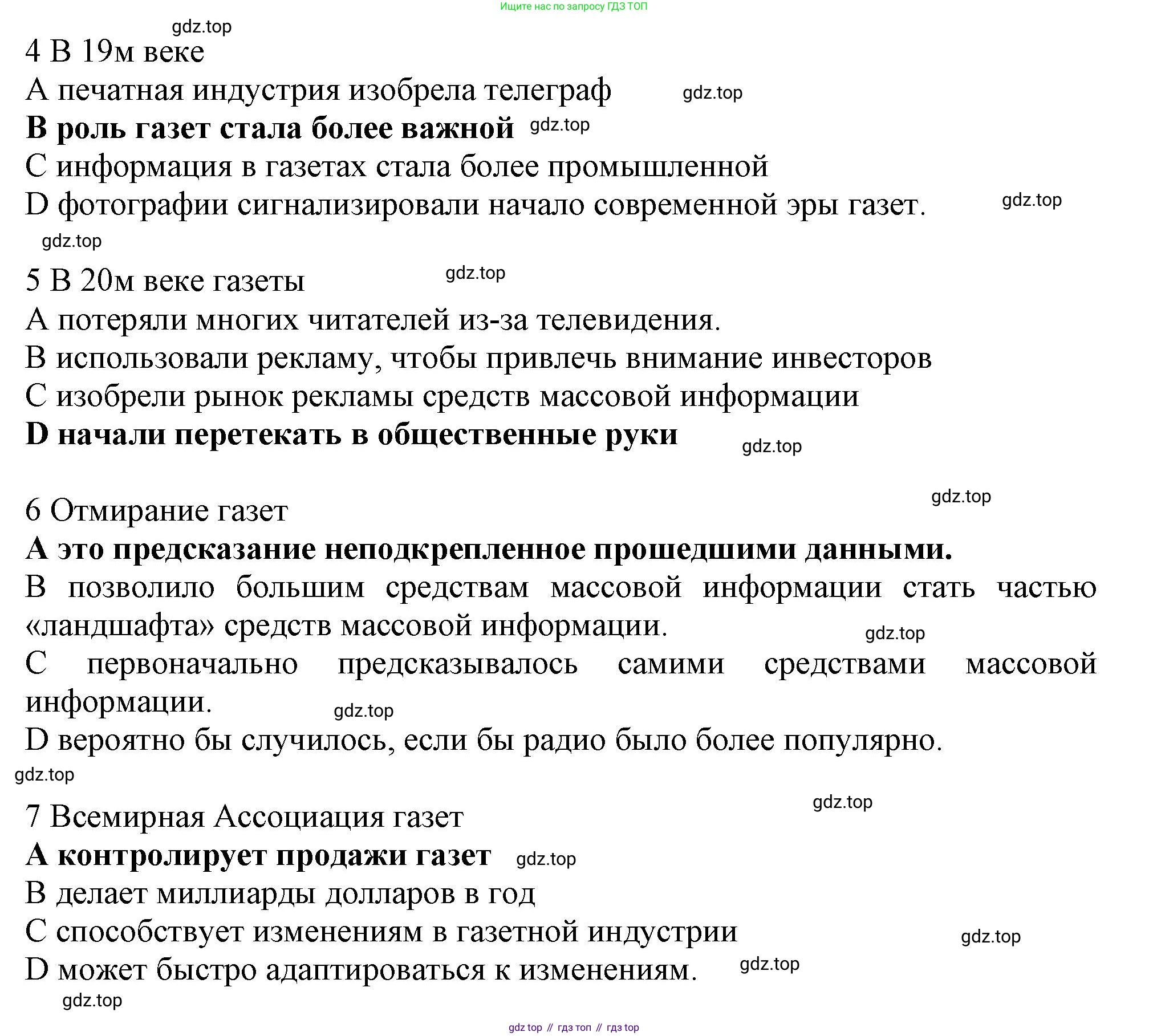Номер 1, страница 51 - гдз по английскому языку 11 класс (spotlight) рабочая тетрадь Афанасьева, Дули

Авторы: Афанасьева О. В., Дули Д., Михеева И. В., Оби Б., Эванс В.
Тип: workbook (Рабочая тетрадь)
Серия: spotlight (английский в фокусе)
Издательство: Просвещение, Express Publishing
Год издания: 2019 - 2025
Уровень обучения: базовый
Цвет обложки: белый, фиолетовый с Тауэрским мостом
ISBN: 978-5-09-096611-5
Популярные ГДЗ в 11 классе
Module 6. Spotlight on Exams - номер 1, страница 51.
№1 (с. 51)
Условие. №1 (с. 51)
скриншот условия

Spotlight on Exams
Reading
1 RNE Read the text, then choose A, B, C or D for questions 1-7.
The History of Newspapers
Newspapers can be traced back to 16th century Venice. In 1566, handwritten news sheets — called 'avisi' or 'gazettes' — filled with information on wars and politics in Europe were distributed weekly in Venice. Similar news sheets soon started to appear in other European countries. By 1615 Germany and Austria were publishing weeklies. And in 1621, the first news sheet appeared in England.
At first, these news sheets only printed news which came from outside the country in which they were printed. Discussion of local or national issues was avoided. Europe's governments did not tolerate anything negative being said about them as it could lead to national unrest.
Such censorship slowed the development of newspapers. Nevertheless, a belief in the importance of a 'free press' slowly began to take hold in Europe. England was among the first countries to escape government control of the press. This occurred during the reign of King Charles I in the 17th century, when, during a period of breakdown in the king's authority, people began to publish what they wanted. Eventually, the press had the right to criticise government and voice other ideas freely. In the middle of the 18th century, Sweden became the first country to make press freedom a part of its law.
In the 19th century, the newspaper industry was transformed by the invention of the telegraph. The telegraph was a communication system that allowed messages to be sent over long distances in a matter of minutes. It wasn't long before newspapers became society's primary means of spreading and receiving information. In 1880, the first photographs appeared in newspapers and, by the end of the century, all the basic technical tools for the modern newspaper were in place.
The story of newspapers in the 20th century was one of adaptation to changing consumer and media markets. The invention of radio, TV, and later the Internet, repeatedly drove newspapers to re-invent themselves. Also, during the 20th century, mass-market advertising increased profitability for newspapers. This attracted large, publicly-owned corporations who began buying newspapers from the descendants of company founders.
Over the years, people have periodically predicted the extinction of newspapers. In fact, every time a new media has come into being, dire predictions have been made for existing forms (e.g. television was supposed to have replaced radio, radio was supposed to have replaced newspapers). Yet history has repeatedly shown that new media do not replace existing media. Instead, what happens is that media consumption grows, which creates the necessary space for the new media to become a part of the media landscape.
According to the World Association of Newspapers (WAN), each day more than 1.5 billion people around the world read a newspaper. The WAN has also estimated the total annual worth of the global newspaper industry and put it at just under 180 billion USD. Such statistics suggest the newspaper industry is healthier than at any other time in its history. Indeed, if the industry proves itself as capable of adapting to change as it has done in the past, it is unlikely that newspapers will be disappearing from newsstands anytime soon.
1 In paragraph 1, we learn that
A news travelled slowly in Europe.
B newspapers get their name from 16th century news sheets.
C daily editions of newspapers were a later development.
D Europe was at war in 1566.
2 The first news sheets
A were checked by authorities.
B avoided all controversial topics.
C were distributed internationally.
D discussed foreign issues.
3 In paragraph 3, we learn that
A England was the first to believe in a free press.
B criticising governments was the original purpose of a free press.
C King Charles I opposed a free press.
D Sweden's 'press freedom' law followed England's.
4 In the 19th century,
A the newspaper industry invented the telegraph.
B the role of newspapers became more important.
C information in newspapers became more technical.
D photos signalled the start of the modern newspaper era.
5 In the 20th century, newspapers
A lost many readers to TV.
B used ads to attract investors.
C invented mass-market advertising.
D began to pass to public hands.
6 The extinction of newspapers
A is a prediction unsupported by past evidence.
B would allow for more media to become part of the media landscape.
C was originally predicted by the media itself.
D would probably have occurred if radio had been more popular.
7 The WAN
A monitors newspaper sales.
B makes billions of dollars a year.
C promotes change within the newspaper industry.
D is able to rapidly adapt to change.
Решение 1. №1 (с. 51)



Решение 2. №1 (с. 51)

Решение 3. №1 (с. 51)

Решение 4. №1 (с. 51)
Ответ:
1. C: daily editions of newspapers were a later development.
(C: ежедневные выпуски газет появились позже.)
2. D: discussed foreign issues.
(D: обсуждали зарубежные проблемы.)
3. C: King Charles I opposed a free press.
(C: Король Карл I был против свободной прессы.)
4. B: the role of newspapers became more important.
(B: роль газет стала более важной.)
5. B: used ads to attract investors.
(B: использовали рекламу для привлечения инвесторов.)
6. A: is a prediction unsupported by past evidence.
(A: это предсказание, не подтвержденное прошлым опытом.)
7. A: monitors newspaper sales.
(A: отслеживает продажи газет.)
Другие задания:
Помогло решение? Оставьте отзыв в комментариях ниже.
Присоединяйтесь к Телеграм-группе @top_gdz
ПрисоединитьсяМы подготовили для вас ответ c подробным объяснением домашего задания по английскому языку за 11 класс, для упражнения номер 1 расположенного на странице 51 к рабочей тетради (workbook) серии английский в фокусе , spotlight (спотлайт) 2019 года издания для учащихся школ и гимназий.
Теперь на нашем сайте ГДЗ.ТОП вы всегда легко и бесплатно найдёте условие с правильным ответом на вопрос «Как решить ДЗ» и «Как сделать» задание по английскому языку к упражнению №1 (с. 51), авторов: Афанасьева (Ольга Васильевна), Дули (Дженни ), Михеева (Ирина Владимировна), Оби (Боб ), Эванс (Вирджиния ), ФГОС (старый) базовый уровень обучения учебного пособия издательства Просвещение, Express Publishing.
















